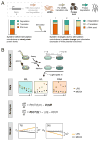Immunogenetics. Dynamic profiling of the protein life cycle in response to pathogens
- PMID: 25745177
- PMCID: PMC4506746
- DOI: 10.1126/science.1259038
Immunogenetics. Dynamic profiling of the protein life cycle in response to pathogens
Abstract
Protein expression is regulated by the production and degradation of messenger RNAs (mRNAs) and proteins, but their specific relationships remain unknown. We combine measurements of protein production and degradation and mRNA dynamics so as to build a quantitative genomic model of the differential regulation of gene expression in lipopolysaccharide-stimulated mouse dendritic cells. Changes in mRNA abundance play a dominant role in determining most dynamic fold changes in protein levels. Conversely, the preexisting proteome of proteins performing basic cellular functions is remodeled primarily through changes in protein production or degradation, accounting for more than half of the absolute change in protein molecules in the cell. Thus, the proteome is regulated by transcriptional induction for newly activated cellular functions and by protein life-cycle changes for remodeling of preexisting functions.
Copyright © 2015, American Association for the Advancement of Science.
Figures




Comment in
-
Gene expression. Statistics requantitates the central dogma.Science. 2015 Mar 6;347(6226):1066-7. doi: 10.1126/science.aaa8332. Science. 2015. PMID: 25745146 No abstract available.
References
Publication types
MeSH terms
Substances
Associated data
- Actions
Grants and funding
LinkOut - more resources
Full Text Sources
Other Literature Sources
Molecular Biology Databases

